
Do you want to better understand gymnastics scoring? Are you wondering how gymnastics judges decide on the score for each gymnastics routine? In this article, we’ll detail the process gymnastics judges go through when coming up with a score.
In this article we’ll specifically be talking about judging USA Gymnastics’s Junior Olympic program, the gymnastics levels 1-10, along with the Xcel Program. If you’re wondering how Elite gymnastics meets and the Olympics are scored, check out Olympic Gymnastics Scoring: The Basics.
We’ve created some gymnastics scoring cheat sheets with a simplified version of the information in this article. Make sure you download them below.
Prefer to watch a video? Check out our 15 Minute Guide to Gymnastics Scoring below:
In order to become a judge you have to memorize the deductions and the routine requirements. At the compulsory levels you need to have memorized the compulsory routines exactly as they are explained in the USA Gymnastics Women’s Compulsory Program Text. The Optional level’s routine requirements and deductions are laid out in the USA Gymnastics Women’s Junior Olympic Code of Points Text.
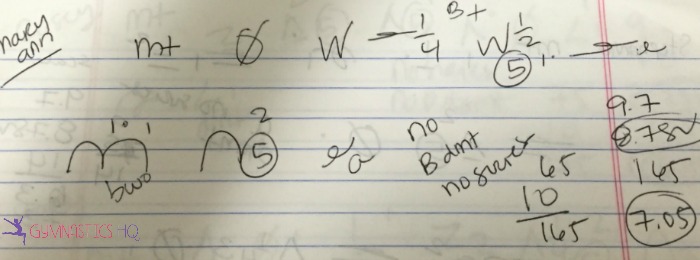
This is a picture of the shorthand I used to judge a routine a long time ago. Please don’t judge the messiness 😉
You also need to learn gymnastics judges’ shorthand, which is a bunch of symbols used to record a gymnast’s routine. Judges write down the symbols that correspond to the skills that the gymnast performed, along with notations for what deductions they are going to take. After a gymnast’s routine is complete, the judge goes back and evaluates the routine based on what they have recorded on their paper.
Since gymnastics judging can be somewhat subjective, given that there are humans applying deductions, the judge’s goal every meet is for the gymnasts to be fairly ranked.
What Gymnastics Judge Looks For in A Gymnastics Routine
For the purposes of this article, we are going to really simplify what judges look for in routines. Depending on a gymnasts level, some things might be slightly different. We also aren’t going to dive into the very specific non-common deductions that judges can take. As a big picture though, we will outline what judges are looking for in routines.
Requirements: Does the gymnast have all the requirements?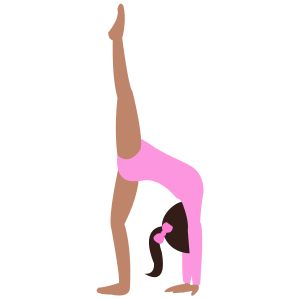
The first thing a gymnastics judge looks at when evaluating a routine is whether the gymnast has all
the routine requirements. This will determine a gymnast’s start value. You can check out the level requirements here.
Compulsory Routine Requirements
In compulsory routines, judges look to make sure all of the skills were performed in the order in which they are supposed to be performed. Here are some of the deductions a judge can take if a compulsory routine doesn’t have all the requirements:
- If a skill is omitted: subtract twice the value of the skill
- If a skill is reversed: subtract half the value of the skill
Optional Routine Requirements
In optional routines, judges look to make sure all of the requirements are fulfilled by skills the gymnast performed. For example, in Level 6 one of the Floor routine requirements is that a gymnast performs “1 salto or aerial element.” So the judge is going to look at their shorthand of the gymnast’s routine and make sure that they wrote down a skill that will fit that requirement, like a front tuck. A deduction is taken if a gymnast is missing one of these requirements:
- If a special requirement is missing: .5
In addition to the “special requirements” at each level, there are also value part requirements. For example, at Level 6, each Bar, Beam and

To learn more about the skill values and level requirements, check out our Skill Progression Checklists.
Floor Routine must have 5 “A” value parts and 1 “B” value part. So the judge makes sure that in their shorthand the gymnast has enough skills to fulfill the value part requirements. Here are the deductions taken if a gymnast is lacking any of the required value parts:
- For an “A” value part: .1
- For a “B” value part: .3
- For a “C” value part: .5
In addition to the special requirements and value part requirements, Levels 9 and 10 need Bonus connections in order to start from a 10.
One other thing judges review their shorthand for that will affect the gymnast’s start value is whether the gymnast performed a skill that is not allowed at that level.
For example, Xcel Gold gymnasts are not allowed to perform “B” valued saltos or any “C” or higher level skill on Floor. If a gymnast performs a skill that is not allowed at their level, a deduction is taken from the start value.
In some cases, performing a skill that is not allowed can void the routine. For example, performing a vault that is not allowed at the level will void the vault — basically meaning the gymnast receives a score of 0.
Execution: How Well Did the Gymnast Perform the Skills?
 The second thing gymnastics judges look at is the execution.
The second thing gymnastics judges look at is the execution.
While they watched the routine, with their shorthand they write down the execution deductions for each skill.
Compulsory Routine Execution
Compulsory routines must be executed exactly like the text says in order for them to be performed flawlessly. Needless to say, it is very rare for this to happen. A skill will have execution deductions for not being performed perfectly. But also, the dance and transition movements can have execution deductions for not being performed exactly how the text describes. Here are some example execution deductions for a compulsory Bars, Beam or Floor routine (Vault has a separate set of deductions):
- Legs separated when they should be together: up to .2
- Balance errors: up to .3
- Bent arms or legs when they should be straight: up to .3
- Changing, reversing or omitting a small part of the routine: .1
As you can see from this small sample of execution deductions, a gymnastics judge uses their discretion to decide how much to take. You might be thinking to yourself, How does a judge know how much to take? Or Doesn’t this makes a score highly subjective?
Keep in mind that a gymnastics judge has seen thousands and thousands of routines, and after seeing that many routines you know every time you see a bent leg whether that is a .1 deduction bent leg, or a .3 deduction bent leg. Judges’ scores are required to be very close to each other (when there are multiple judges on a panel) or there is a discussion. This helps to keep the scores consistent.
Optional Routine Execution
What Judges Look for On All Skills
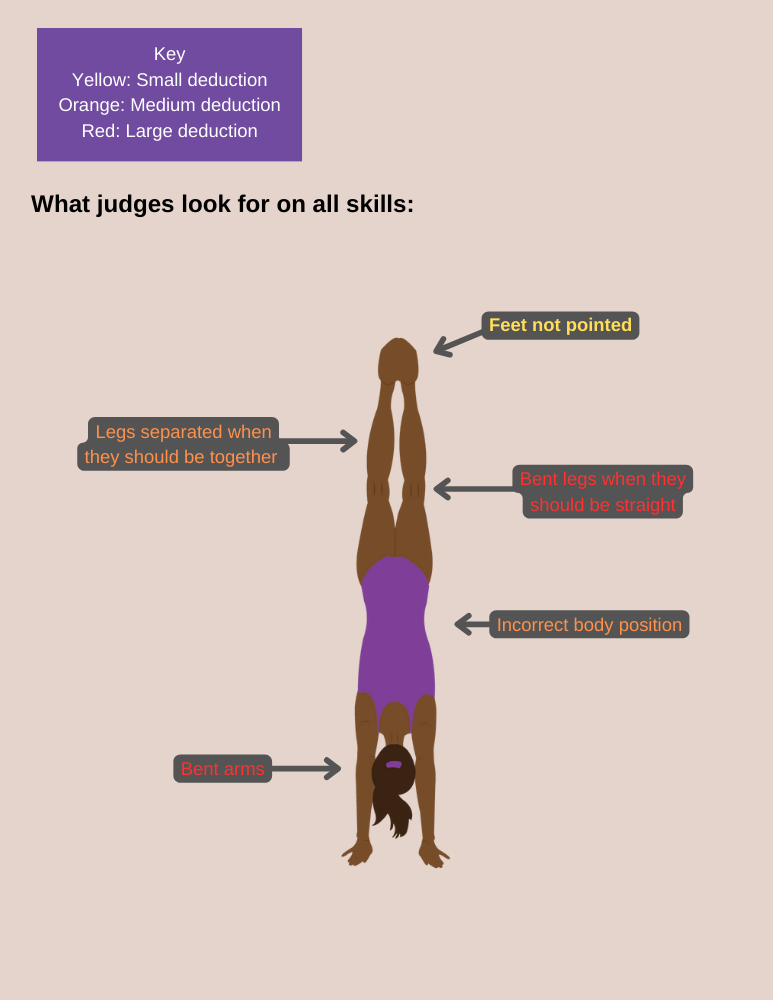
In optional routines, the skills are evaluated for execution. For each skill, a gymnastics judge must ask the question:
Is this skill being executed perfectly according to the JO Code of Points? And if not, what execution deductions apply?
Here are some example execution deductions for optional routines:
- Leaps, jumps, hops not rising enough off the floor or beam, not enough height: up to .2
- Toes not pointed on a skill: .05
- Leg or knee separations: up to .2
As you can see from that tiny sample of execution deductions, they cover every aspect of a gymnastics skill. You can see small errors, such as not pointing your toes, can add up throughout the routine.
What Judges Look For on Jumps and Leaps

For jumps and leaps, judges are looking to make sure the gymnast has achieved the right angle, has sufficient height and maintains a good body position throughout.
What Judges Look for In Turns

In turns on floor and beam, judges are loooking to make sure the gymnast makes all the way around to where she is supposed to – whether its a half turn or a full turn. They are also looking to make sure that the gymnast performs the turn in high relevé and maintains a tight body position throughout.
Overall Performance: Did this Gymnast’s Routine “Wow”?
After a gymnastics judge has determined a routine’s start value based on the requirements, and then taken deductions for execution, the judge looks at the overall routine and determines any other general deductions. A judge is keeping in mind the ranking of the gymnasts at the meet, and is also comparing the overall routine to other routines from the same level that the judge has seen.
then taken deductions for execution, the judge looks at the overall routine and determines any other general deductions. A judge is keeping in mind the ranking of the gymnasts at the meet, and is also comparing the overall routine to other routines from the same level that the judge has seen.
Artistry & Dynamics
There are artistry and dynamics deductions that can be taken based on how the overall routine is performed. These are deductions that can be used to help better rank the gymnasts.
Composition Deductions
Starting at Level 8, routines have additional deductions that can be taken based on how the routine was composed. As an example, are all the hard skills at the beginning of the routine? As opposed to spread out throughout the routine?
Miscellaneous Deductions
One last thing a judge must consider before deciding the gymnast’s score is if there are any miscellaneous deductions that need to be taken. There are flat deductions for things like stepping out of bounds, being spotted during the routine, going overtime, not presenting to the judge, etc.
Once these four aspects are evaluated: requirements, execution, overall performance and miscellaneous deductions, a score is computed.
This is an overall look at scoring, but how does this apply to each event? Each event follows the same structure with its own set of unique considerations.
Vault Scoring
The first thing you need to know about scoring gymnastics vaults is that there are three phases to a vault, and deductions are applied at each phase.
3 Phases of Vault
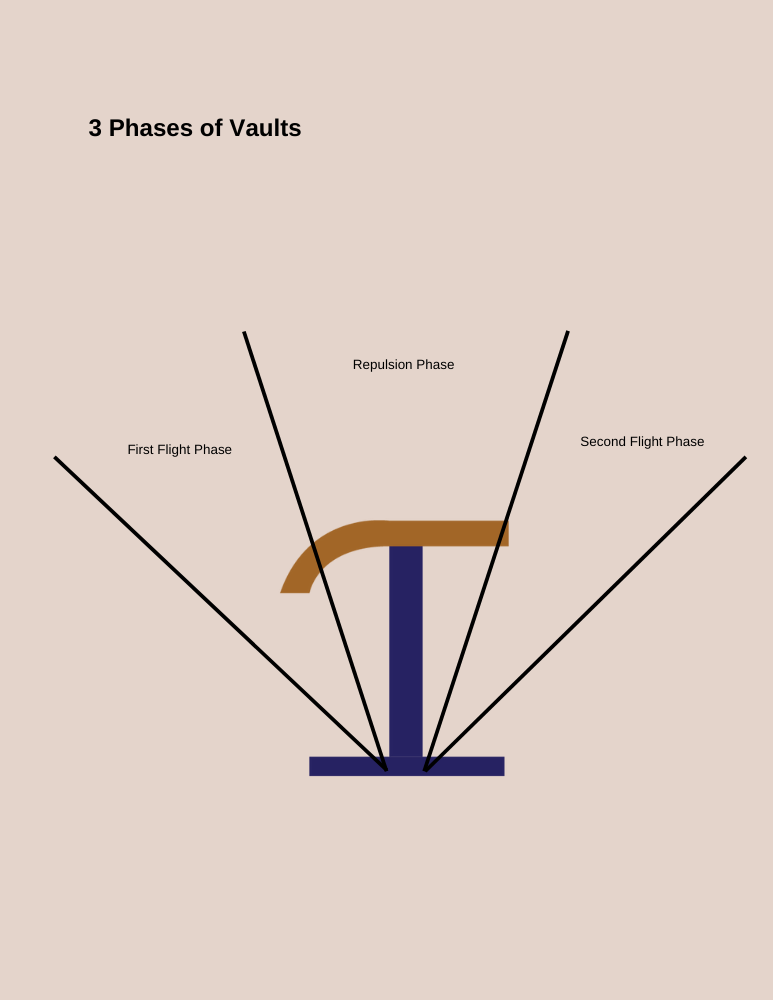
The three phases are the first flight phase (when the gymnast is in between the springboard and the vault table), the support and repulsion phase (when the gymnast is on the vault table) and the second flight phase. So if a gymnast has bent legs throughout the vault, the deduction is taken three times.
Vault Angles
One of the most important things when evaluating a gymnast’s vault are the angles. A judge watches closely to see what angle she came on to the vault table, and what angle she exited. For example, when performing the compulsory Level 4/5 Handspring Vault, the gymnast must push off the vault table by the time she hits vertical or a deduction of up to 1 full point can be taken depending on the degree past vertical the gymnast leaves the table.
Dynamics
Dynamics is a bigger deduction on vault than on the other events. Vaults should be powerful, with good height.
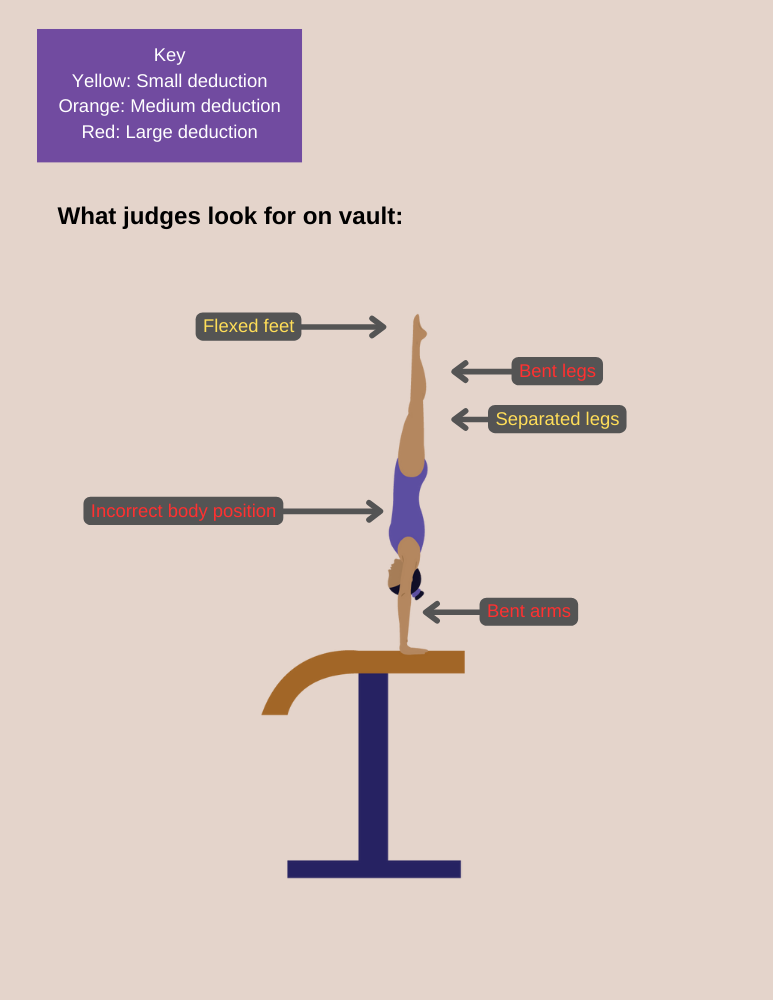
Bars Scoring
Angles on Bars
Like on vault, one of the most important aspects of scoring bars is the angles of each of the skills. Every level has different requirements for the angle of the casts. The angle that handstands achieve and the angle out of circling elements is important at higher levels.
For example, in Level 7 on Bars one of the requirements is that the gymnast performs a cast a minimum of 45 degrees from vertical. So the judge is watching the angle of each of the casts the gymnast performs. In order to fulfill the requirements, the gymnast must do a cast to a minimum of 45 degrees from vertical on one of her first two casts. After the first two times a gymnast performs a skill it can’t be used to satisfy the requirement, but additional low casts will still incur deductions.
Rhythm
The rhythm of a bar routine is important. The skills should be performed in a row without extra casts, swings or stops.
- Extra cast or swing: .3
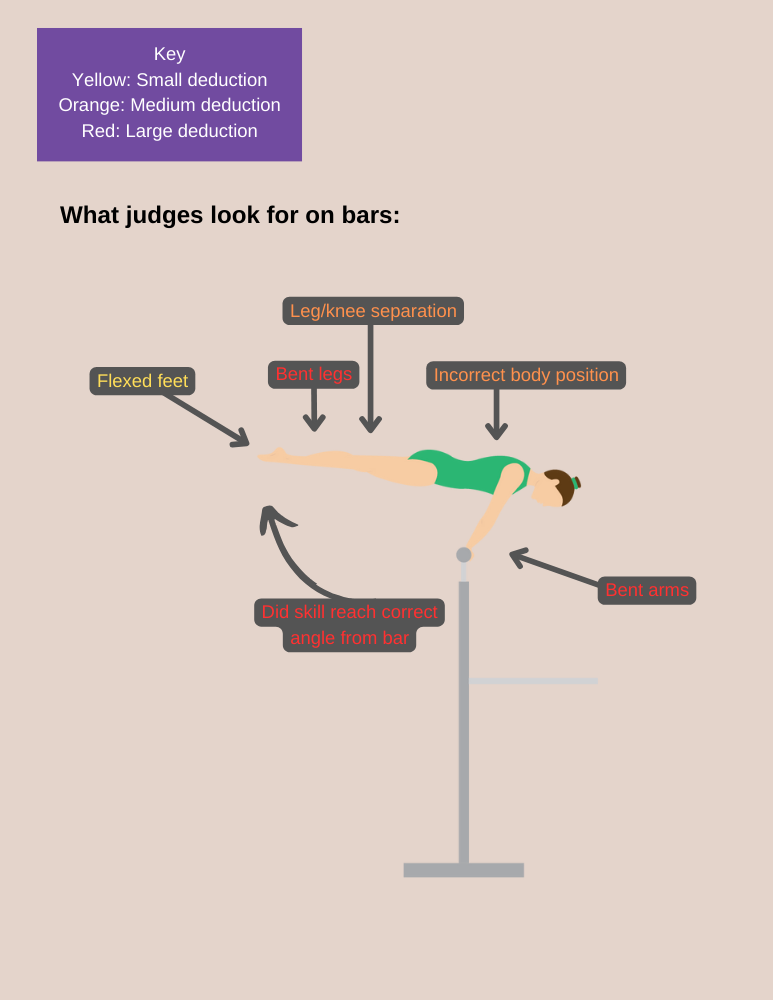
Beam Scoring
Balance
As you can imagine, one of the most important factors when evaluating a gymnast’s beam routine is her 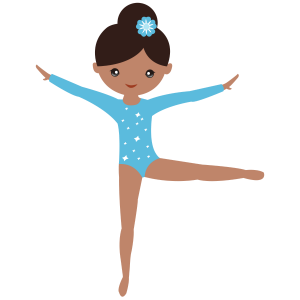 balance. Every balance error is a deduction. A balance error can be small (a tiny wobble) or large (making lots of big movements).
balance. Every balance error is a deduction. A balance error can be small (a tiny wobble) or large (making lots of big movements).
- Balance errors: up to .30
- Fall: .5
Height and Angle of Jumps and Leaps
Every jump and leap performed is evaluated for height off the beam. Split jumps and leaps are evaluated for what angle was achieved.
One of the most often asked questions by parents about beam scores is why did one gymnast get a better score than the other gymnast even though the gymnast with the better score fell off the beam and the other gymnast didn’t? As you can see, there are so many factors that go into scoring a beam routine, and a fall is just one deduction that can be taken.
Floor Scoring
Height and Angle of Jumps and Leaps
Just like on beam, the height of jumps and leaps are evaluated. Split jumps and leaps are assessed for what angle was achieved. If a jump or leap turns, the feet are watched closely for the degree of the turn.
Height and Form of Tumbling Skills
Tumbling passes are evaluated on a number of factors, some of which are the body position during the skills, the height of saltos and the landings.
As you can see, while the overall framework of coming up with a score is the same across gymnastic events, there are different points of emphasis.
Obviously, we can’t explain every deduction, or every factor that goes into determining a gymnastics score (the books that do explain are several hundred pages). But, we hope this article has helped you to understand the process of gymnastics scoring. Now test your knowledge here — Can you pass this Gymnastics Scoring Quiz?
Prefer to listen to this article instead of read it? Listen to the audio below.



Abby January 29, 2017, 12:12 pm
I was just wondering, if you were in level eight gymnastics on floor, can the judges take points off if you don’t do any back skills? Even though you have all the requirements.
gymnasticshq January 31, 2017, 2:32 pm
Yes, there is a deduction for lack of variety in saltos–you need to have saltos in 2 different directions–forward, backward, sidewards. So if you only have forward skills you should learn a sidewards one also.
Abby January 31, 2017, 2:48 pm
Okay thanks! Is a front half considered a side skill?
gymnasticshq January 31, 2017, 2:53 pm
Nope, sorry.
Abby January 31, 2017, 2:57 pm
Okay, thanks for your help.
CK August 21, 2018, 8:36 am
Yes. A gymnast must perform skills from the two direction from either; backward skills and the forward/sideways skills. (ie: on FX L8-10, front layout step out directly connected to a round off back handspring back layout salto. Has 2 acro[tumbling] directions)
Kelly March 16, 2017, 11:50 pm
How much of a deduction is it in level 7 if your hand touches the beam during a wolf turn to avoid falling off?
Marie January 29, 2019, 9:18 pm
The deduction can be .3 to .5 depending on how much you rely on the beam
C Black May 2, 2017, 9:05 am
I have read the code of points, etc. for Xcel Platinum over and over. Our Coach is new to gymnastics. Our daughter completed all season with missing skills and without skills that would get her a 10.00 start value on B, B and F. Can you tell me what she can do to score higher this year? Thanks.
mars March 11, 2022, 10:40 pm
You said she was missing skills and wasn’t starting at a 10, so there is the obvious, meet all of the requirements for platinum. But, you also want to focus on technique. Even if a flexed food or bent leg doesn’t seem like a lot, that is where most deductions come from. Practice basics like kicks, cartwheels, handstands, etc. with perfect form and eventually this will transfer over to your actual skills. Hope this helped!
Gymnastbum May 8, 2017, 6:22 pm
My daughter is an Excel Gold gymnast. This past weekend she competed at the States Meet, during the awards ceremony her name was not called even though we knew she had placed higher than some girls that went up to the podium, when I approached her coach I was told that my daughter was put into the wrong session that she should of competed the previous day. So my daughter was not acknowledged at all for her achievements at states, we don’t even know where she placed or if she even placed at all.
My question is because she competed on a different day, with different judges how true will her score or placement be once it is put against the girls her age group that competed the day before?
Naomie January 20, 2018, 11:37 pm
If you are Second year gold do the judge take away pots if you don’t do a back walk over on beam?
Maisie October 26, 2018, 3:53 pm
Probably
maya November 12, 2018, 10:59 pm
Nope no deductions. As long as the skills fit the requiremnets its fine.
kai February 21, 2018, 11:39 am
i was wondering how bonus is used in optional routines… what combinations make how much bonus?
F.O.C.U.S February 24, 2018, 9:11 pm
How can i help my gymnast keep her feet pointed?
Vivi May 20, 2021, 7:06 am
you can let her sit gently on her feet and push her ankles out. This should help.
Jenna March 31, 2018, 1:04 am
My daughter is left handed. How do we know where she is loosing points due to reversing the skills? Is this listed somewhere?
Thank you. .
apktrends.joomla.com March 31, 2018, 3:15 am
It can be greater than your stock texting app.
Catalina May 8, 2018, 1:15 pm
I love gymnastics and I love what you are doing with this website. Very nice. Do you know someone that sells used gymnastics equipment?
homescapes tricks May 31, 2018, 12:05 am
It’s accessible on iOS and Android platforms.
Karen Ball September 26, 2018, 11:03 am
Hey Jessica!
I have been in contact with you before about HS gymnastics and judging. I live in Huntington Station and direct Gold Medal Club Teams at our 6 locations. Need your advice for designing judging sheets for our in house judges….hope you can help.
You can email me or contact me by cell 631-807-7406
Thanks!!
Karen
gymnasticshq September 27, 2018, 1:22 pm
Hi Karen,
Sure! Do you want to email me what you have ? Or the questions you have? My email is jessica@gymnasticshq.com 🙂
Cammy December 28, 2018, 3:06 pm
My daughter is in level 8. She is doing well but I feel like her routines look great and she must be getting the same deductions each meet because her scores are all similar with no glaring mistakes. I am trying to learn how to spot mistakes but don’t have an eye for it yet. It is possible to send you videos of her routines and pay you to help show where she can improve her scores? Thanks for any help . Cammies Dad
PinkGymnast12 March 22, 2019, 2:16 am
This website is truly amazing. I used SO many of your links for a school project, and it was my main source! The accuracy is incredible and I really want to become a judge at 16 as well, so this was REALLY help in addition to USAG’s website. Thank you for all the work you’ve put into this, it truly is making such a BIG impact!
gymnasticshq March 24, 2019, 3:08 pm
Thanks so much! Glad you’ve found our website helpful!
ali August 4, 2019, 2:52 pm
the quiz isn’t working for me .. it lets me do the first question but doesn’t work after that
TRACEY A COOK October 30, 2019, 2:03 pm
My daughter just did her first JO1 meet and the person put her scores into the computer wrong. Rather than 2 first place and one tie she got one 1st place and did not even place on the others. Should we be expected them to acknowledge that this happened?
I brought it to their attention and they confirmed it was a mistake on their part but have not addressed it since.
Barbara Anne May December 23, 2019, 10:26 am
THANK YOU for writing this article! I am a National level gymnastics judge and this is the best explanation I have ever seen as to how scores are compiled. I have done many Parent’s Judges Education Meetings and this is EXACTLY what I go over! Wish I would have found this article sooner. I give it a 10.0 ~ Barbara Anne May
Royale February 18, 2021, 9:10 am
how can you get 1 place?
Daniel December 13, 2021, 2:50 pm
For XCel competitions, my daughter performs 2 vault passes. For judging purposes, do they take the higher score OR the average of the 2?
Sam March 15, 2022, 12:33 am
They take the higher of the two
Greg Werner May 9, 2023, 11:52 am
This is wonderful and I have the entire list of deductions in front of me for my daughter’s level, 4. Perfectly explained between the two of them. But still, and I am not a judge, for say vault how can a judge process that much information in such a short time. I am in awe of their ability to do so and see how each judge must have everything memorized but still to apply all this judgment in such a split second is quite a talent.
Samantha October 29, 2023, 2:08 pm
Is the score allowed to change once it has been presented?
Nicole February 4, 2024, 6:44 pm
What is “insufficient” height? I can’t seem to find this anywhere. When an athlete has insufficient height, is there an actual amount the judges are looking at or is it wholly subjective?
Thank you!